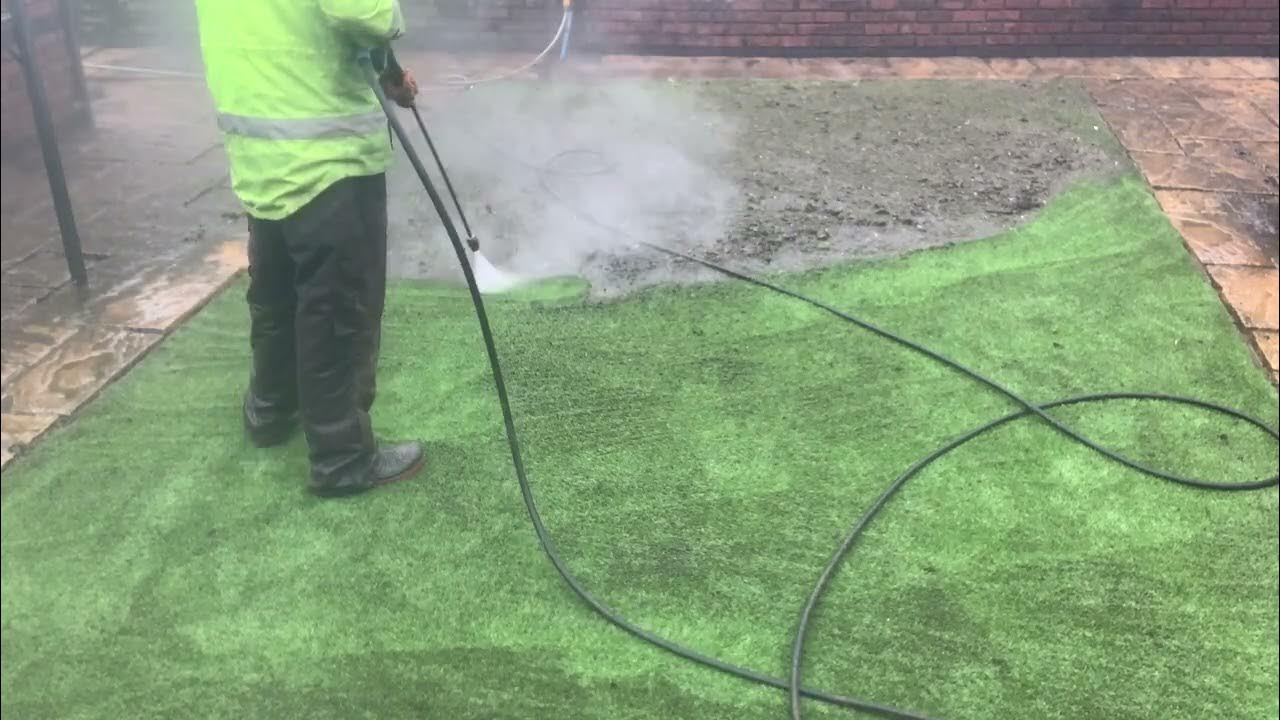
Artificial turf has become a popular landscaping choice for homeowners who want that perfect green look—without all the mowing, fertilizing, or muddy mess. But as time goes on, even synthetic grass can get grimy from dust, pet messes, fallen leaves, and outdoor spills. So, a question often comes up:
“Can I use a pressure washer to clean artificial turf?” 🤔
The short answer is: yes, but with caution. A pressure washer can be a useful tool for cleaning synthetic grass, but only if you use the right settings and techniques. Done improperly, pressure washing could damage your turf’s fibers or base material.
Let’s explore how to safely pressure wash artificial grass, when to use it, and what other cleaning methods might work just as well (or better). 🧽🌱
🤔 Why Clean Artificial Turf in the First Place?
Just like any outdoor surface, synthetic turf collects debris and grime over time. Regular maintenance helps keep it looking vibrant, feeling fresh underfoot, and smelling clean—especially if you have pets.
Common turf contaminants include:
- Dust and dirt from foot traffic
- Pet waste or urine 🐾
- Spilled food or drink
- Fallen leaves and pollen
- Moss, mold, or algae growth in shaded areas
- Gum or sticky residue
Left untreated, these can create odor, discoloration, and even mildew buildup. Yikes! 😷
⚠️ Risks of Using a Pressure Washer on Turf
While pressure washing may seem like a quick fix, using the wrong settings or techniques could do more harm than good.
❌ Potential Hazards:
- Fiber Damage
Artificial grass blades are made from polyethylene or nylon. High PSI can fray, bend, or break the turf fibers. - Infill Displacement
Turf usually contains infill (sand, rubber, or a combo) that keeps the blades upright. Strong pressure can blow this material out of place, leading to uneven surfaces or bare spots. - Backing Damage
The turf is held together by a mesh or rubber backing. Pressure washing too closely or at a steep angle can weaken this backing, causing rippling or lifting. - Edge Lifting
If the turf isn’t perfectly secured, the strong spray could lift the edges and damage the installation.
In short: use pressure, not power. 💧⚠️
✅ How to Safely Pressure Wash Artificial Grass
If you’re going to use a pressure washer on your synthetic turf, follow these best practices to get the clean without the catastrophe:
1. Use Low to Moderate Pressure (Under 1,500 PSI)
More is not better here. Aim for 1,200–1,500 PSI max. This is enough to dislodge grime but gentle enough to avoid tearing fibers.
2. Use a Wide Spray Nozzle (25° or 40° Tip)
Avoid narrow-angle tips (0° or 15°), which can focus water too intensely on a small area. A wider fan helps spread the pressure evenly.
3. Maintain a Safe Distance
Keep the spray nozzle 12 to 18 inches above the turf. Too close, and you risk gouging the material or pushing infill out.
Browse Amazon Here For Top Rated Power Washers And Accessories
4. Spray at a Shallow Angle
Hold the wand at about a 30–45° angle, not straight down. This helps prevent water from pushing deep into the backing or soil base.
5. Work in Sections
Start with a small area, spray in overlapping passes, and move methodically across the turf.
6. Avoid Harsh Cleaners
If you’re using a detergent, make sure it’s pet-safe, turf-safe, and biodegradable. Avoid bleach or acidic cleaners.
🐶 Dealing with Pet Odors?
Pet urine is one of the biggest turf complaints—especially in hot weather.
- First, rinse with a garden hose regularly
- For deep cleaning, use an enzyme-based turf cleaner specifically designed to neutralize odors
- Pressure washing can help flush out the infill, but be sure to replenish it afterward if it gets displaced
🧴 Pro tip: Let the cleaner sit for 5–10 minutes before rinsing to break down organic residue.
🌞 When to Use a Pressure Washer vs. a Garden Hose
Here’s when each tool is most effective:
| Task | Garden Hose 🚿 | Pressure Washer 💦 |
|---|---|---|
| Light dust & leaves | ✅ Best choice | Overkill |
| Pet urine | ✅ With cleaner | ✅ Use gently |
| Gum or sticky spots | ❌ Not effective | ✅ Spot clean only |
| Moss, mildew | ❌ Limited reach | ✅ With caution |
| Major spills or grime | ❌ Limited power | ✅ Controlled setting |
So, you don’t need a pressure washer for most maintenance. But for deep cleaning or after a major mess, it can be a great helper—if handled responsibly.
🧼 Alternatives to Pressure Washing Turf
In many cases, you can skip the pressure altogether with these gentler options:
- Leaf blower for dust and debris 🍂
- Turf rake to lift matted fibers
- Pet enzyme sprays for odor control 🐕
- Push broom with mild soap and water for spot scrubbing
- Turf vacuum for artificial grass with infill
These methods are often safer and easier to manage for routine cleaning.
🧠 Final Thoughts
So, can you pressure wash artificial turf?
Yes—but only if you’re careful. A pressure washer can be a powerful cleaning tool for synthetic grass, but it comes with real risks if used incorrectly. The key is moderation.
To keep your turf looking fresh:
- 💧 Use low pressure
- 🌱 Keep your distance
- 🧼 Use turf-safe detergents
- 🔁 Avoid blasting away infill
- 🐶 Spot-treat pet areas regularly
With the right approach, you can enjoy that lush, green look without damaging your investment. 🌿✨
Browse Amazon Here For Top Rated Power Washers And Accessories






